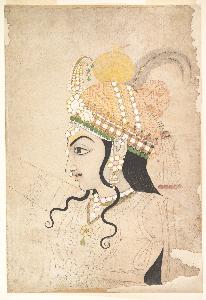Sahib Ram
Sahib Ram
Mjesto: Jaipur
Rođen: 1745
Smrt: 1803
Biografija:
Sahib Ram was an Indian artist who was born in Jaipur, India in 1745 and died in 1803. He was a prominent figure in the royal suratkhana (workshop) active during the reigns of Maharaja Madho Singh I and his son Maharaja Sawai Pratap Singh. Sahib Ram is best known for his work in opaque watercolor on paper, and is attributed to several works in the collection of the Metropolitan Museum of Art in New York City.
Early Life and Training
Sahib Ram was born into a family of artists and received his training from his father, who was also a painter. He was known for his exceptional skill in capturing the intricate details of the royal court and its surroundings. His work is characterized by bright colors, flatness, and abstract form, as well as a preference for universal themes over individualistic ones.
Artistic Style
Sahib Ram's artistic style is a unique blend of traditional Indian techniques and European influences. He was known for his use of opaque watercolor on paper, which gave his paintings a distinctive texture and appearance. His work is also characterized by its attention to detail and its ability to capture the essence of the subject.
- His most famous works include Singer and Sarinda Player, which showcases his skill in capturing complex narratives through his use of color, composition, and character depiction.
- Portrait of Maharaja Pratap Singh (1764–1803) is another notable work, which demonstrates his ability to capture the intricacies of the royal court and its surroundings.
- His work can be found in various museums, including the Cleveland Museum of Art, which houses a significant collection of his paintings.
Legacy
Sahib Ram's legacy is not limited to his own work. He has also influenced generations of artists who have followed in his footsteps. His unique style and technique have been studied and emulated by many, and his work continues to be celebrated and admired today. Important works by Sahib Ram can be found on https://Wikioo.org, which offers a vast collection of Indian art from the 18th century. The website also provides information on other artists, including Purkhu and Raja Ravi Varma, who have made significant contributions to Indian art. In conclusion, Sahib Ram was a master of Indian art, known for his unique style and technique. His work continues to be celebrated and admired today, and his legacy has influenced generations of artists who have followed in his footsteps.



